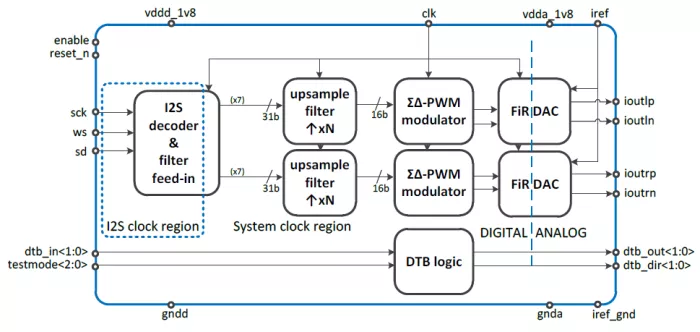The AXIOM_PULLFIRDAC is a high accuracy sigmadelta digital-to-analog converter. The low out-of-bandnoise (OOBN) down to -60dBFS makes the converter ideally suited for application with strict OOBN requirements. The PWM modulator is a special type of 1-bit sigma-delta modulator that produces a pulse width modulated (PWM) signal with a fixed repetition frequency. A fixed repetition rate makes the output signal insensitive to non-linear inter symbol interference (ISI).
The semi-digital FIR filter topology of the FIRDAC makes the FIRDAC behave as a multi-bit DAC. This gives the converter its excellent OOBN and makes the system robust against clock jitter and other error sources typically associated with 1-bit converters while maintaining excellent THD and good matching properties.
The AXIOM_PULLFIRDAC is ideally suited for digitalto- analog conversion in front of (analog) class-D or class-AB amplifiers. In addition this IP is delivered together with up-sampling / interpolation filters as signal pre-processing. The design and layout of the FIRDAC is a highly automated process, easy to scale and good portable to several CMOS technologies.
High Accuracy, low-noise sigma delta DAC
Overview
Key Features
- Dynamic range: 117 dB (20 - 20kHz)
- Excellent THD performance: nTHD < -110 dBFS
- Low out-of-band-noise (OOBN): -60 dBFS
- Good matching properties
- Robust against clock jitter
- Insensitive to inter symbol interference (ISI)
- Multi-bit advantages with a single bit modulator
- Silicon proven in CMOS 0.14 um
- Differential current outputs
- High output compliance: no direct need for buffer
- Area: 0.75 mm2 per channel
Block Diagram

Applications
- High accuracy digital-to-analog conversion with low OOBN
- Signal generation for class-D and class-AB amplifiers
- Audio subsystem
- Makes a complete audio front-end system in combination with up-sampling filters and digital audio interface
Technical Specifications
Maturity
Silicon proven in CMOS 0.14 um
Related IPs
- 24-bit Sigma Delta Charge-Redistribution DAC (High bandwidth)
- 24-bit Sigma Delta Stereo Audio Ulter low area silicon provenin 28nm DAC
- Low power 24bit few Ksps sigma Delta silicon proven DAC IP Core
- 8-bit, 1MSPS low-noise high accuracy analog-to-digital converter
- 16 Bit Sigma Delta AD Converter
- 14 Bit Sigma Delta AD Converter